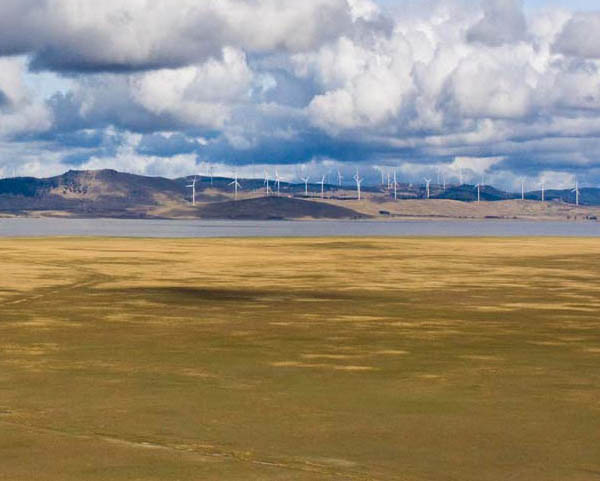Huge holes remain to be filled in the “centrepiece” of government climate policy. [6 May 2014 | Peter Boyer]
The Abbott government’s first major climate policy statement since it was elected last September was quietly slipped into the public domain on the eve of the Anzac Day long weekend.
It was as if the government didn’t want us to notice it, which wouldn’t be surprising.
“Emissions Reduction Fund White Paper” was its title, but that was a misnomer. “Blank paper” would have been more accurate. Its 100 pages provide no clear idea as to how this central plank of the government’s four-year-old “Direct Action” plan will work.
Ever since Tony Abbott pulled out of an agreement with Labor to implement emissions trading in December 2009, the Coalition has campaigned relentlessly against any form of carbon pricing, in particular the scheme enacted under Julia Gillard’s government.
Along with the Renewable Energy Target (RET), that scheme remains the centrepiece of Australia’s climate response. It will continue to be so until the legislation that set it up is repealed.
Environment minister Greg Hunt says the scheme is ineffectual, but data from 2012-13 show that it’s starting to have an impact where it matters: on emissions from coal-fired power generation. And it’s up and running, a big advantage given the long lead time needed by all these schemes.
Against this we have little more than an idea. Tony Abbott has now been in charge of the Coalition for well over four years. In all that time he has said precious little about Direct Action, and eight months into office legislation is yet to be drafted, let alone enacted and implemented.
It isn’t that the Emissions Reduction Fund (ERF) idea is without merit. The plan is to fund projects like improving energy efficiency of homes and commercial buildings, capturing landfill gas, and upgrading vehicles, improving logistics, revegetating marginal lands and improving soils. All good.
But plant and soil sequestration, already being addressed under the Carbon Farming Initiative, is no silver bullet in dealing with emissions. According to all current research, the white paper’s assumption that this will have an early impact on our carbon bottom line is plain wrong.
An ERF or something like it might serve to support investment in emission reduction, maybe sitting alongside the present economy-wide pricing scheme. But for the Coalition to retain carbon pricing after three years of relentless, high-profile campaigning to get rid of it would be a bridge too far.
The white paper leaves the strong impression that the ERF is, at best, a complimentary measure. A crucial shortcoming is compliance. We still have no idea how, or even whether, the government will deal with companies refusing to participate or failing to meet contractual obligations.
As precious time ticks away, Hunt continues to insist that his party is firmly committed to cutting carbon emissions. But that’s all we have: a promise with nothing to back it up. Given the fate of some other election promises, this is looking very grim.
For four years Greg Hunt has been the public face of Direct Action, his signature climate policy. Its success depends heavily on the ERF. If this proves a dud, the government’s climate policy will be in ruins. In which case you’d think Hunt’s political career couldn’t be far behind.
But there’s more in play here.
I’ve written before about the conviction of some influential Australian businessmen that humans don’t cause climate change: people like Dick Warburton, who heads the government’s review of the RET, and Maurice Newman, Tony Abbott’s business advisor.
Strongly opposed to effective action against fossil-fuel emissions, such as constraints on coal-fired electricity generation, these people are capable by themselves of doing great damage to Australia’s effort to curb emissions. But they also have fellow-travellers in parliament.
The months since the Abbott government took office have seen some disturbing signals from politicians about their attitude to our growing but still-vulnerable renewable energy market, notably during the parliamentary debates on repeal of carbon pricing laws.
We’ve heard the prime minister suggest that renewable energy costs too much (which may be all the encouragement Dick Warburton needs to recommend killing off the RET). Last week treasurer Joe Hockey bought into the debate in an interview with Alan Jones on Radio 2GB.
When Jones asked why the government was “chasing Thai and Chinese-subsidised wind turbines down the road with a chequebook”, Hockey suggested that next week’s Budget might tackle renewable energy subsidies and the “massive duplication” of multiple environmental agencies.
He said that the government would “get rid of the Clean Energy Regulator”, the same agency that Greg Hunt wants to help operate his Emissions Reduction Fund. A spokeswoman later said Hockey meant the Clean Energy Finance Corporation, which the government really does want to abolish.
There was also this extraordinary outburst: “I drive to Canberra to go to parliament, and I must say I find those wind turbines around Lake George to be utterly offensive. I think they’re a blight on the landscape.”
I wonder, does Hockey find them more of a blight than thousands of gas drills installed on farmland against owners’ will? More of a blight than expanding open-cut coal mines intruding into peoples’ lives, properties and communities and affecting their health in his own state as well as in Queensland?
Hockey’s remarks are instructive. His confusion over the Clean Energy Regulator suggests his own party’s climate policy has a low profile in his scheme of things. And his wind turbine comment is straight from the songbook of Maurice Newman and his anti-windpower friends.
With a government hell-bent on destroying existing carbon abatement mechanisms and yet to put a convincing case that it will deal effectively with the climate crisis, these are dark days indeed.

